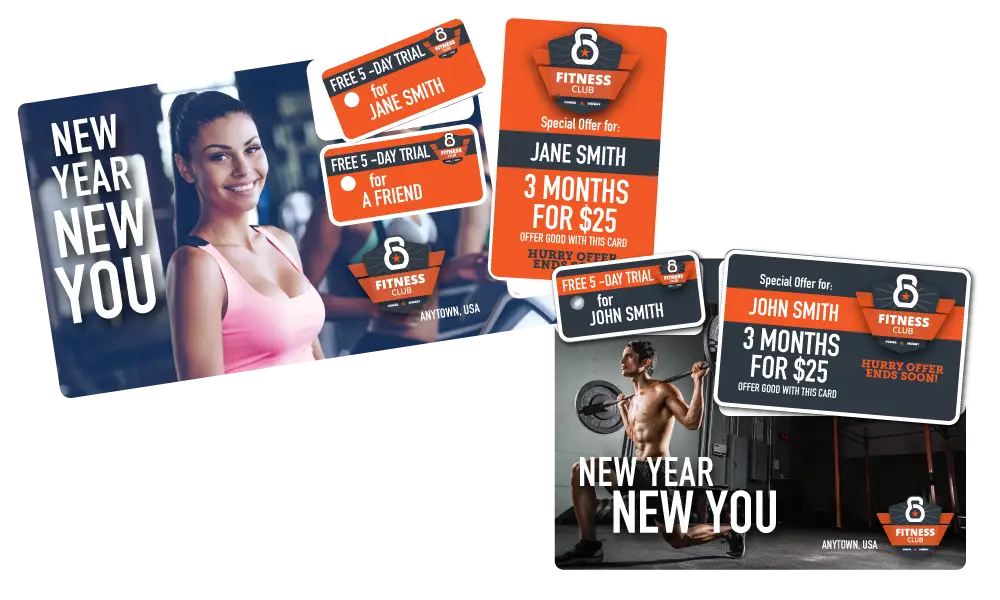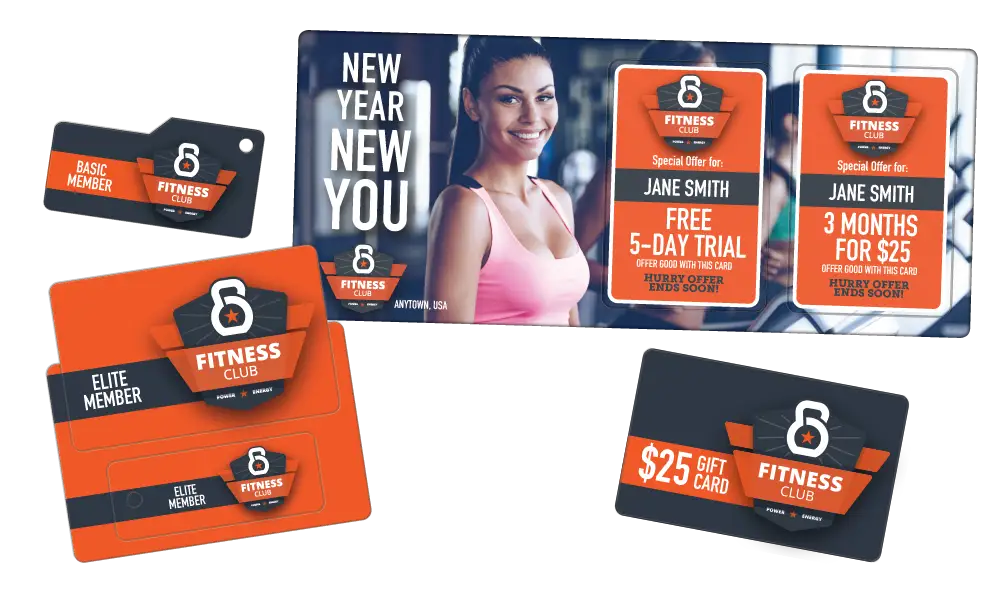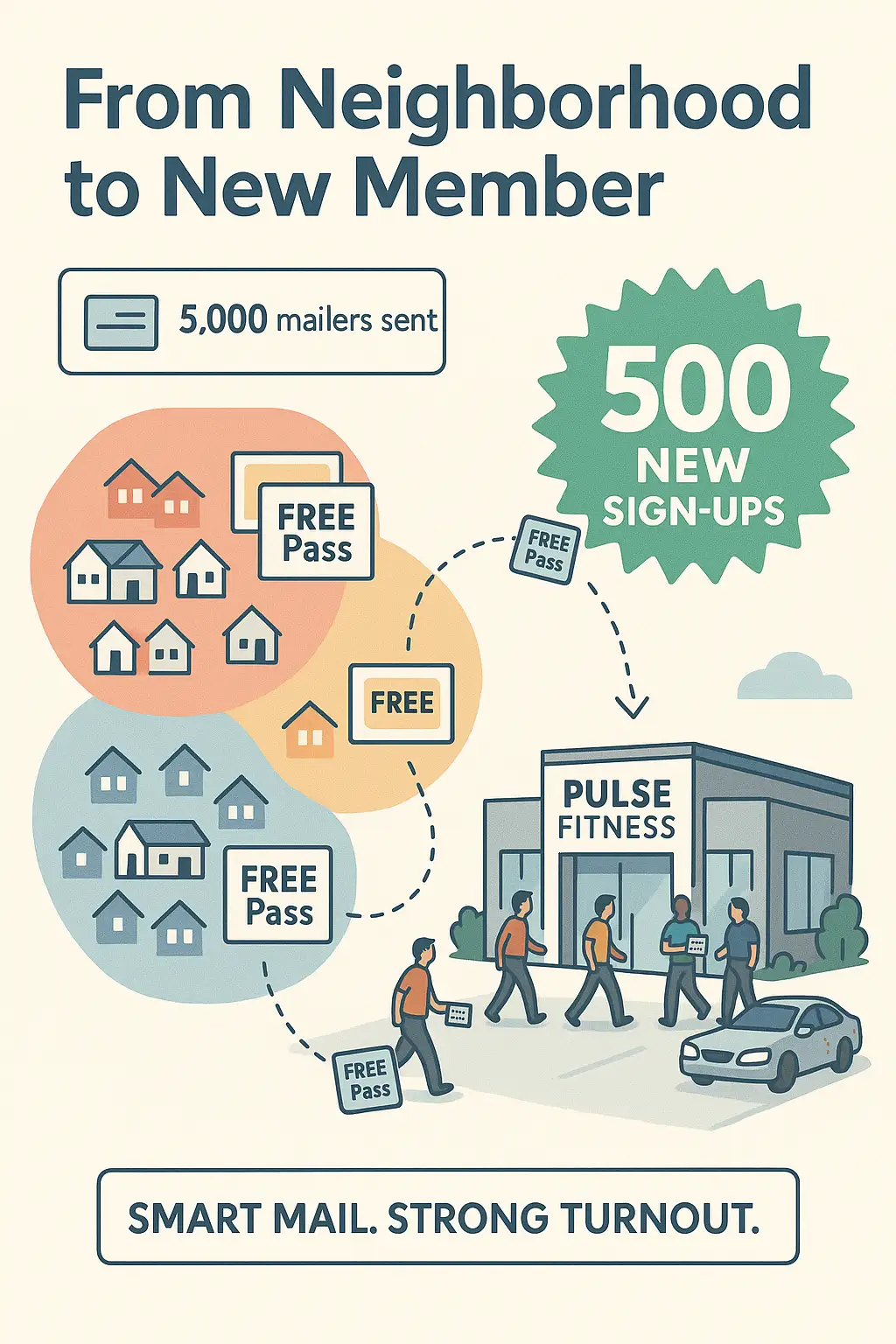Fitness centers are, or at least they should be, constantly seeking innovative ways to attract new members and retain existing ones, especially in today’s fast-paced, digital-first world. While online ads and social media dominate many marketing strategies, one tried-and-true method continues to deliver exceptional results: direct mail. Specifically, direct mail campaigns using laminated postcards due to their ultra-high redemption rates and impressive return on investment (ROI). These postcards stand out in mailboxes, resembling gift cards in their finish and texture, and include a pop-out coupon that drives convenience and boosts redemption. This blog explores why direct mail remains a powerhouse for fitness centers, common mistakes gyms make with direct mail marketing, and the types of offers that maximize success in fitness industry campaigns. We’ll dive deep into how fitness centers can leverage this effective marketing tool to grow their customer base and increase revenue.
Why Direct Mail Still Works for Gyms in the Digital Age
 The fitness industry is highly competitive, with fitness centers vying for attention in a crowded market. Many assume digital marketing, social media, email blasts, or pay-per-click ads, is the only way to reach today’s tech-savvy consumers. However, direct mail remains a surprisingly effective marketing tool, particularly for fitness centers aiming to stand out. According to industry data, traditional postcard direct mail boasts response rates up to 10-30 times higher than digital channels, with 42% of recipients reading or scanning direct mail pieces. For gyms, direct mail marketing offers a tangible, personal touch that digital ads often lack.
The fitness industry is highly competitive, with fitness centers vying for attention in a crowded market. Many assume digital marketing, social media, email blasts, or pay-per-click ads, is the only way to reach today’s tech-savvy consumers. However, direct mail remains a surprisingly effective marketing tool, particularly for fitness centers aiming to stand out. According to industry data, traditional postcard direct mail boasts response rates up to 10-30 times higher than digital channels, with 42% of recipients reading or scanning direct mail pieces. For gyms, direct mail marketing offers a tangible, personal touch that digital ads often lack.
One key advantage of gym direct mail is its ability to target specific demographics with precision. Fitness centers can tailor their campaigns to reach local households within a certain radius, focusing on age groups, income levels, or lifestyle preferences that align with their target audience. For example, a fitness center near a suburban neighborhood might send direct mail to families, offering group discounts, while an urban gym could target young professionals with promotions for personal training sessions. This hyper-local approach ensures the message reaches those most likely to join.
Laminated direct mail postcards elevate this strategy further. Unlike standard paper postcards, laminated versions are durable, resisting wear from rain, snow, or the rough handling of the mail stream. Their glossy, gift-card-like finish grabs attention, making recipients more likely to hold onto and redeem them. The pop-out coupon feature adds convenience, allowing recipients to detach a wallet-sized offer they can carry to the gym, share with a friend, or redeem on the spot. This combination of durability, visual appeal, and practicality drives redemption rates far higher than oversized paper postcards, often yielding a higher ROI. In fact, laminated postcards can achieve redemption rates of 10-15%, compared to 3-5% for traditional paper postcards.
Direct mail also fosters trust and credibility. A physical piece of mail feels more personal than a fleeting digital ad, and recipients are more likely to perceive it as a genuine offer from a local fitness center. For gyms, this trust translates into foot traffic and new memberships. By combining a custom design that reflects the gym’s brand with a compelling offer, perhaps on a biodegradable postcard, direct mail campaigns become a powerful tool to engage the community and grow the customer base.
Common Mistakes Gyms Make with Direct Mail Marketing
While direct mail marketing for gyms is highly effective, many fitness centers fall into common traps that undermine their campaigns. Avoiding these mistakes can make the difference between a campaign that flops and one that drives significant membership growth.
- Poor Targeting: One of the biggest errors is sending direct mail to a generic, unsegmented audience. Fitness centers often blast postcards to entire zip codes without considering their target audience. For example, a high-end gym offering premium personal training sessions might waste resources mailing to low-income households unlikely to afford their services. Instead, gyms should use data-driven insights to identify their ideal customer base—such as fitness enthusiasts, busy professionals, or families—and tailor their direct mail to those groups. Tools like demographic data or customer purchase history can refine targeting, ensuring the right message reaches the right people.
- Weak Offers: Another common mistake is crafting offers that fail to motivate action. A vague “10% off your first month” might not entice someone to visit a fitness center, especially if they’re bombarded with competing promotions. Effective gym direct mail campaigns feature bold, specific offers that create urgency, such as “Free 30-Day Membership” or “Complimentary Personal Training Session with Sign-Up.” These offers must be clear, valuable, and time-sensitive to drive redemptions.
- Overlooking Design: A poorly designed postcard can doom a campaign before it begins. Many gyms skimp on custom design, opting for generic templates that blend into the mailbox clutter. Laminated direct mail postcards stand out visually and feel premium. The wallet-friendly, gift card-like coupon, indefinitely extends the likelihood of redemption, making it easy for recipients to redeem the offer or pass it to a coworker, friend, or family member. Fitness centers should invest in vibrant colors, bold headlines, and imagery that showcases their facilities or success stories to capture attention.
- Ignoring Follow-Up: Direct mail is not a one-and-done tactic. Some fitness centers send a single batch of postcards and expect instant results, but successful campaigns often involve multiple touchpoints. For example, a fitness center might send an initial postcard with a free trial offer, followed by a second mailing targeting non-responders with a different incentive, like a discounted group class. This multi-step approach reinforces the message and keeps the gym top-of-mind. Regular mailings become affordable and manageable when using a pay-as-you-go subscription service.
- Neglecting Tracking: Without tracking, gyms can’t measure the success of their direct mail campaigns. Many fail to include unique codes or QR codes on postcards to monitor redemptions. Laminated postcards with pop-out coupons make tracking easier, as recipients bring the coupon to the gym, allowing staff to log redemptions accurately. This data helps fitness centers calculate ROI and refine future campaigns for better results.
By avoiding these pitfalls, fitness centers can maximize the impact of their gym direct mail efforts, driving higher redemption rates and building a loyal customer base.
Types of Offers That Work Best in Fitness Direct Mail Campaigns

- Free Trials or Membership Periods: Offering a free trial—such as a 7-day, 14-day, or 30-day gym membership—is a proven way to attract new members. These offers lower the barrier to entry, allowing prospects to experience the fitness center’s facilities, classes, or equipment without commitment. For example, a postcard might read, “Try Us Free for 14 Days!” with a pop-out coupon for easy redemption. Free trial offers can achieve redemption rates of 10% or higher, especially when paired with a laminated postcard’s durability and gift-card-like appeal.
- Complimentary Personal Training Sessions: Personal training is a high-value service that appeals to both new and experienced gym-goers. Offering a free personal training session as part of a direct mail campaign can entice recipients to visit the gym and experience its expertise firsthand. The pop-out coupon makes it easy to redeem this offer, and recipients may share it with a friend or family member, expanding the campaign’s reach. For example, “Get a Free Personal Training Session ($75 Value)” can create excitement and drive foot traffic.
- Discounted Memberships with Urgency: Time-sensitive discounts, such as “Join Now and Save 50% on Your First 3 Months,” create a sense of urgency that motivates action. These offers work well because they appeal to cost-conscious consumers while encouraging quick decisions. Laminated postcards enhance this strategy by ensuring the offer remains intact and visually striking, even after days in a mailbox.
- Group or Family Plans: Fitness centers can target specific segments, like families or friend groups, with offers for discounted group memberships. For instance, “Bring a Friend and Get 2 Months for the Price of 1” encourages recipients to share the coupon with someone else, amplifying the campaign’s impact. The wallet-friendly pop-out coupon makes it easy to pass along, increasing the likelihood of multiple sign-ups from a single mailing.
- Seasonal or Event-Based Promotions: Tying offers to holidays, New Year’s resolutions, or local events can boost engagement. For example, a fitness center might send direct mail postcards in December with a “New Year, New You” theme, offering a free month of classes to kickstart fitness goals. The laminated postcard’s durability ensures it survives the holiday mail rush, while the pop-out coupon makes redemption convenient.
Why Laminated Postcards Excel in Gym Direct Mail
The choice of direct mail format matters, and laminated postcards are a game-changer for fitness centers. Their gift-card-like finish and texture make them stand out in a stack of mail, instantly grabbing attention. The pop-out coupon adds a layer of convenience, allowing recipients to detach a wallet-sized offer they can redeem at a moment’s notice or share with others. Unlike oversized paper postcards, which can tear or fade, laminated postcards are built to withstand the elements and the harshness of the mail stream. This durability ensures the offer remains pristine, increasing the likelihood of redemption.
Moreover, laminated postcards deliver a higher ROI. While they cost slightly more to produce than paper postcards, their redemption rates, often 10-15% compared to 3-5% for paper, make them a cost-effective choice. For example, a fitness center mailing 1,000 laminated postcards might see 100-150 redemptions, compared to 30-50 for paper postcards, resulting in more memberships and greater revenue, yet their cost is marginally more. The ability to extend the redemption window and track redemptions via the pop-out coupon further enhances ROI by providing clear data on campaign performance.
Conclusion


